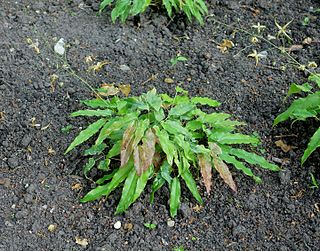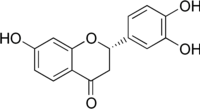
Polyphenols are a large family of naturally occurring phenols. They are abundant in plants and structurally diverse. Polyphenols include flavonoids, tannic acid, and ellagitannin, some of which have been used historically as dyes and for tanning garments.

Quercetin is a plant flavonol from the flavonoid group of polyphenols. It is found in many fruits, vegetables, leaves, seeds, and grains; capers, red onions, and kale are common foods containing appreciable amounts of it. It has a bitter flavor and is used as an ingredient in dietary supplements, beverages, and foods.

Naringenin is a flavanone from the flavonoid group of polyphenols and is commonly found in a variety of citrus fruits and is the predominant flavonone in grapefruit. Naringenin has demonstrated numerous biological activities, including anti-inflammatory properties, antioxidant activity and skin healing. It is used as a cosmetic ingredient and dietary supplement. Naringenin is thought to be responsible for CYP3A4 suppression in the intestinal wall, that may result in serious changes of pharmacokinetics in drugs related with this enzyme.
Chiral column chromatography is a variant of column chromatography that is employed for the separation of chiral compounds, i.e. enantiomers, in mixtures such as racemates or related compounds. The chiral stationary phase (CSP) is made of a support, usually silica based, on which a chiral reagent or a macromolecule with numerous chiral centers is bonded or immobilized.

β-Pinene is a monoterpene, an organic compound found in plants. It is one of the two isomers of pinene, the other being α-pinene. It is colorless liquid soluble in alcohol, but not water. It has a woody-green pine-like smell.

Astragalus mongholicus, synonyms including Astragalus propinquus and Astragalus membranaceus, commonly known as Mongolian milkvetch in English; 'Хунчир' in Mongolian; huáng qí, běi qí or huáng huā huáng qí, in Mongolia, is a flowering plant in the family Fabaceae. It is one of the 50 fundamental herbs used in traditional Mongolian medicine. It is a perennial plant and it is not listed as being threatened.

Honokiol is a lignan isolated from the bark, seed cones, and leaves of trees belonging to the genus Magnolia. It has been identified as one of the chemical compounds in some traditional eastern herbal medicines along with magnolol, 4-O-methylhonokiol, and obovatol.

Dalbergia odorifera, fragrant rosewood or Chinese rosewood, is a species of true rosewood in the genus Dalbergia. It is a small or medium-sized tree, 10–15 metres (33–49 ft) tall. It is endemic to China and occurs in Fujian, Hainan, Zhejiang, and Guangdong.

Sophora flavescens, the shrubby sophora, is a species of plant in the genus Sophora of the family Fabaceae. This genus contains about 52 species, nineteen varieties, and seven forms that are widely distributed in Asia, Oceania, and the Pacific islands. About fifteen of these species have a long history of use in traditional Chinese medicines.

Anthocyanins, also called anthocyans, are water-soluble vacuolar pigments that, depending on their pH, may appear red, purple, blue, or black. In 1835, the German pharmacist Ludwig Clamor Marquart gave the name Anthokyan to a chemical compound that gives flowers a blue color for the first time in his treatise "Die Farben der Blüthen". Food plants rich in anthocyanins include the blueberry, raspberry, black rice, and black soybean, among many others that are red, blue, purple, or black. Some of the colors of autumn leaves are derived from anthocyanins.

Scutellarin is a flavone, a type of phenolic chemical compound. It can be found in the Asian "barbed skullcap" Scutellaria barbata and the north American plant S. lateriflora both of which have been used in traditional medicine. The compound is found only in trace amounts in the "Chinese skullcap" Scutellaria baicalensis, another plant used in traditional Chinese medicine.

Prenylated flavonoids or prenylflavonoids are a sub-class of flavonoids. They are widely distributed throughout the plant kingdom. Some are known to have phytoestrogenic or antioxidant properties. They are given in the list of adaptogens in herbalism. Chemically they have a prenyl group attached to their flavonoid backbone. It is usually assumed that the addition of hydrophobic prenyl groups facilitate attachment to cell membranes. Prenylation may increase the potential activity of its original flavonoid.

Huáng bǎi, huáng bó or huáng bò is one of the fifty fundamental herbs of traditional Chinese medicine. Known also as Cortex Phellodendri, it is the bark of one of two species of Phellodendron tree: Phellodendron amurense or Phellodendron chinense.

Herbacetin is a flavonol, a type of flavonoid.

Syringetin is an O-methylated flavonol, a type of flavonoid. It is found in red grape, in Lysimachia congestiflora and in Vaccinium uliginosum. It is one of the phenolic compounds present in wine.

Retusin is an O-methylated isoflavone, a type of flavonoid. It can be found in Fabaceae species like Dipteryx odorata, in Dalbergia retusa and in Millettia nitida. It can also be found in Maackia amurensis cell cultures.

Miquelianin is a flavonol glucuronide, a type of phenolic compound present in wine, in species of St John's wort, like Hypericum hirsutum, in Nelumbo nucifera or in green beans.

Epimedium wushanense, the Wushan fairy wings, is a flowering plant species in the genus Epimedium.

Liquiritin is the 4'-O-glucoside of the flavanone liquiritigenin. Liquiritin is one of flavone compounds derived from licorice.

6,7,4′-Trihydroxyflavone (6,7,4'-THF) is a flavone, a naturally occurring flavonoid-like chemical compound which is found in heartwood of Dalbergia odorifera, which is called "Jiangxiang" in Traditional Chinese medicine.



















